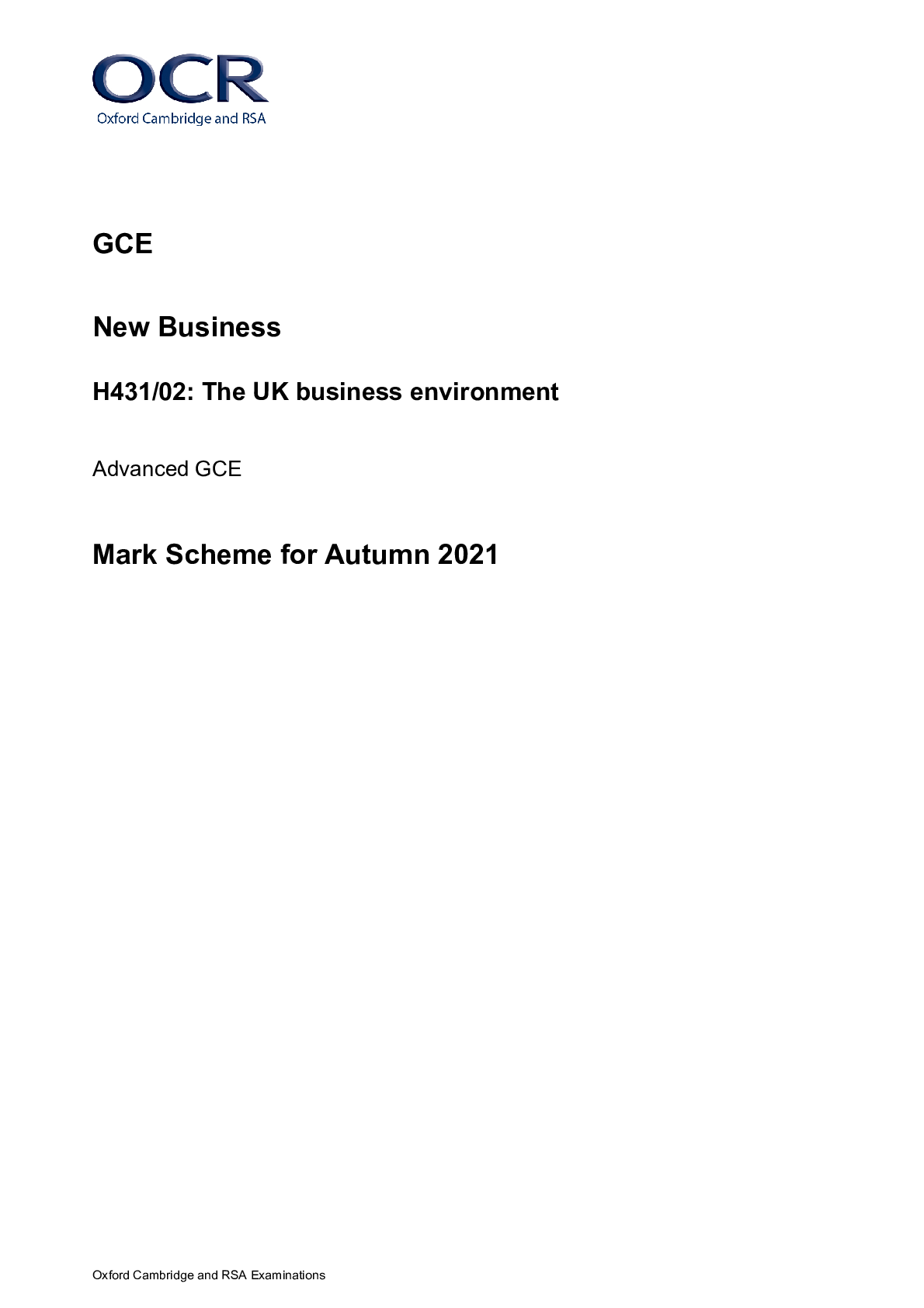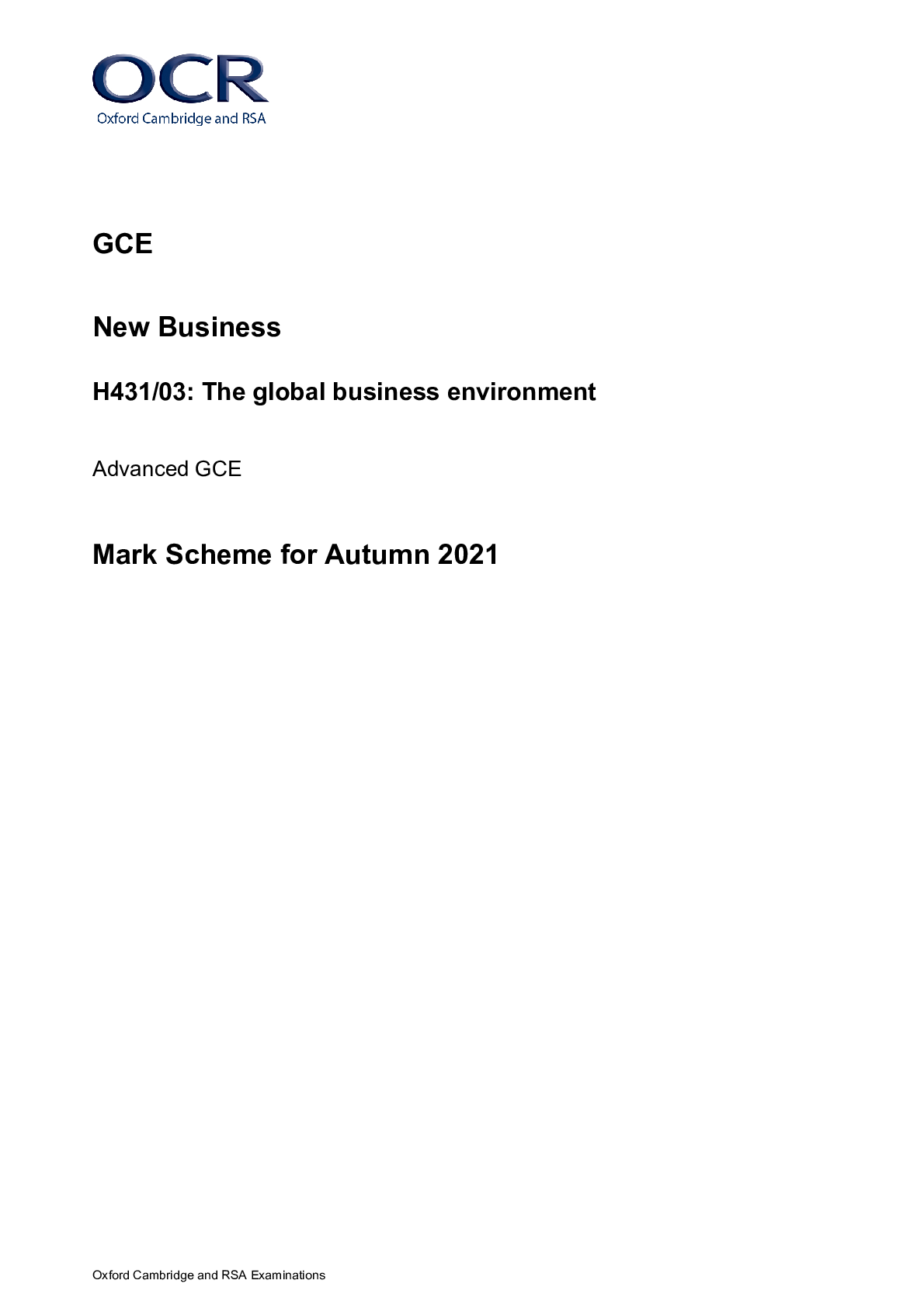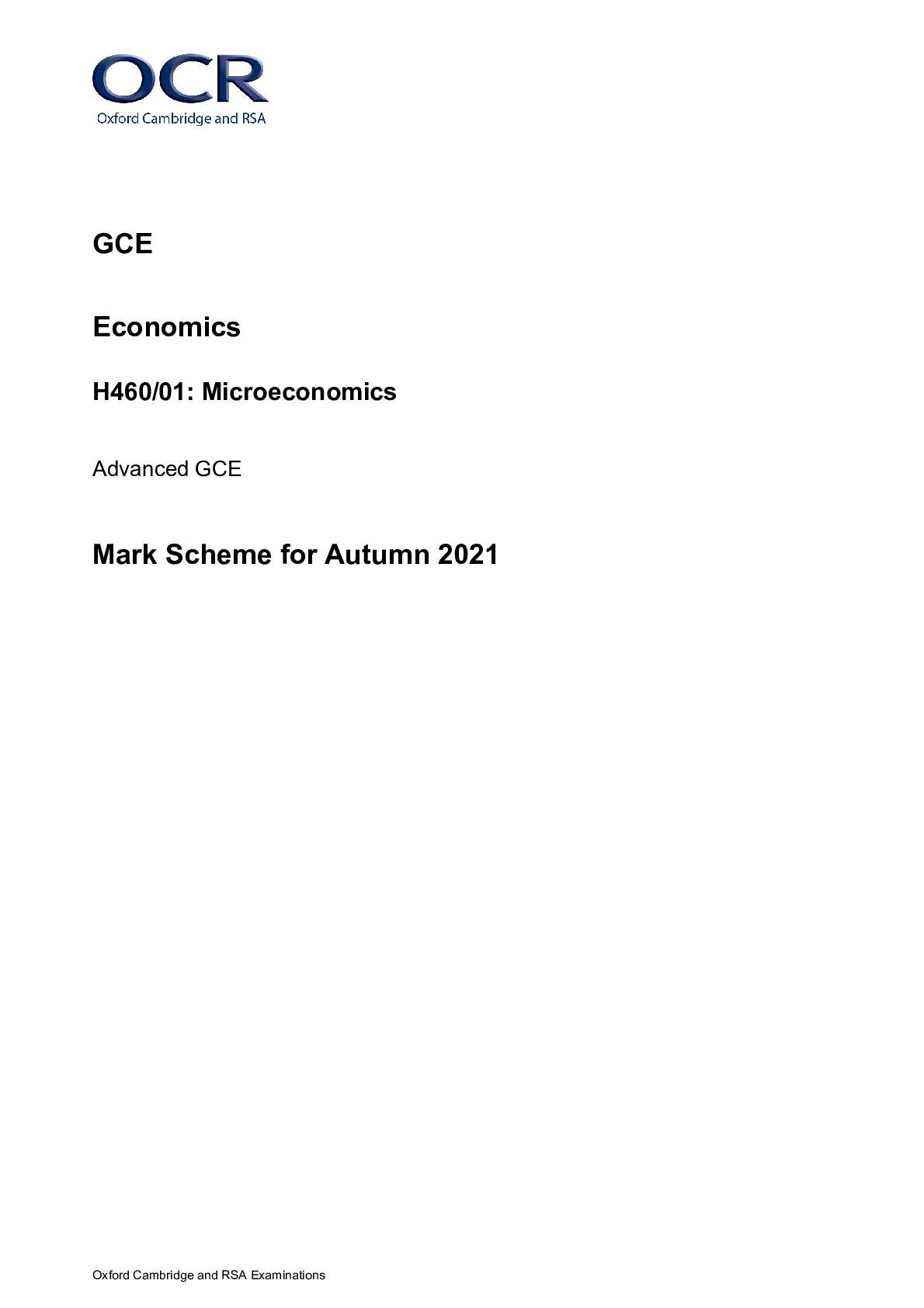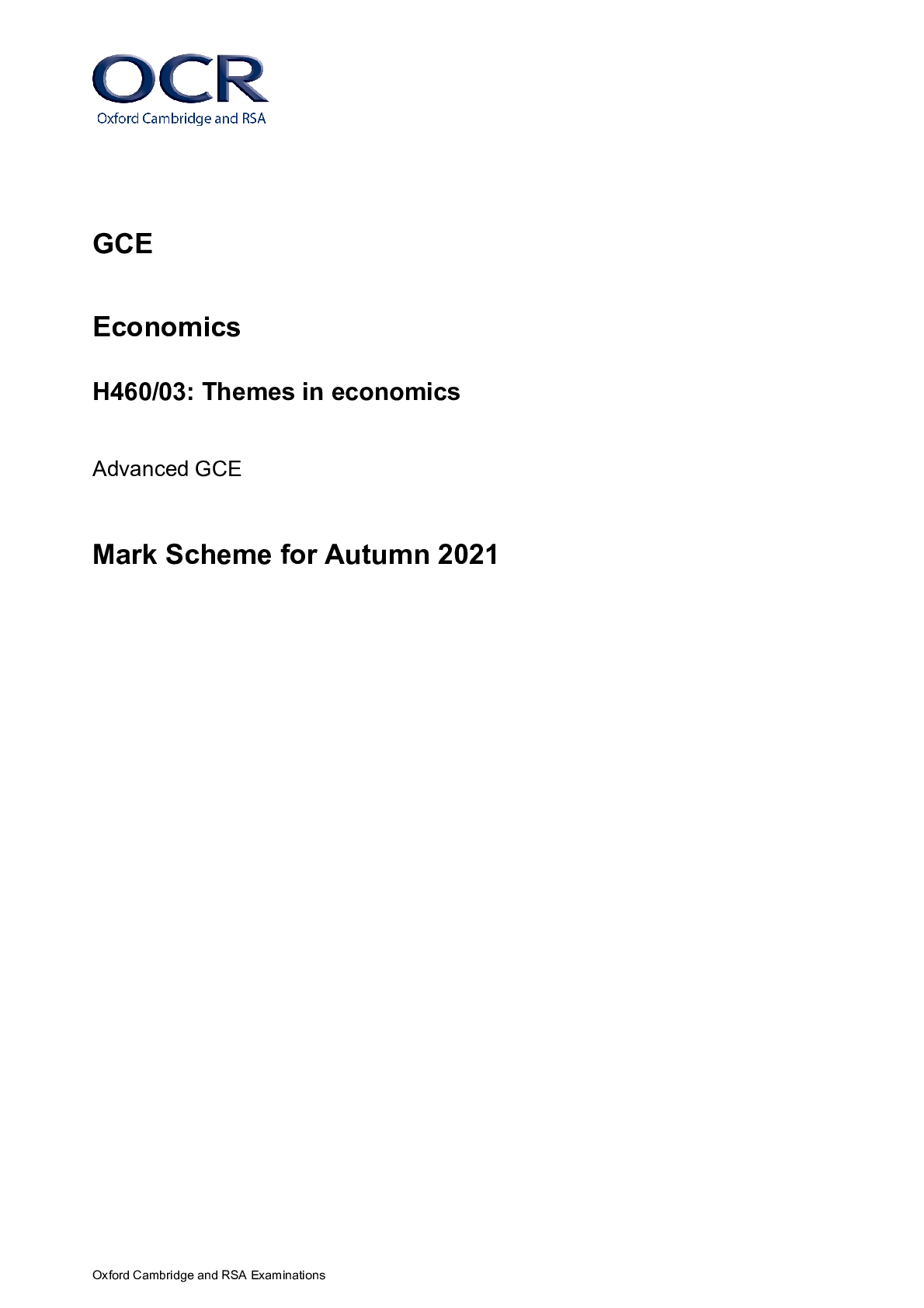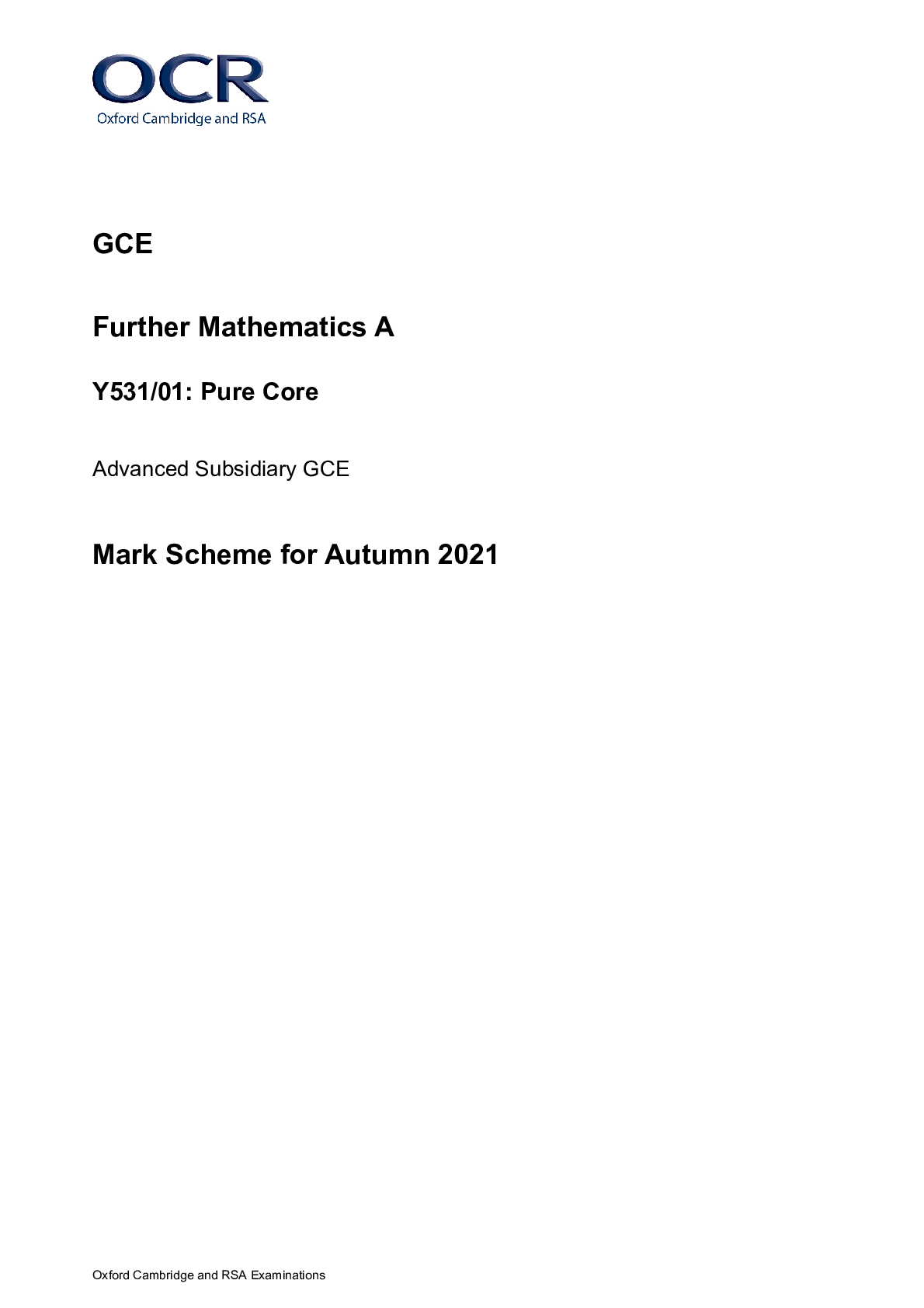Religious Studies > MARK SCHEME > GCE Religious Studies H573/01: Philosophy of religion Advanced GCE Mark Scheme for Autumn 2021 (All)
GCE Religious Studies H573/01: Philosophy of religion Advanced GCE Mark Scheme for Autumn 2021
Document Content and Description Below
GCE Religious Studies H573/01: Philosophy of religion Advanced GCE Mark Scheme for Autumn 2021 Oxford Cambridge and RSA Examinations GCE Religious Studies H573/01: Philosophy of religion Ad... vanced GCE Mark Scheme for Autumn 2021Oxford Cambridge and RSA Examinations OCR (Oxford Cambridge and RSA) is a leading UK awarding body, providing a wide range of qualifications to meet the needs of candidates of all ages and abilities. OCR qualifications include AS/A Levels, Diplomas, GCSEs, Cambridge Nationals, Cambridge Technicals, Functional Skills, Key Skills, Entry Level qualifications, NVQs and vocational qualifications in areas such as IT, business, languages, teaching/training, administration and secretarial skills. It is also responsible for developing new specifications to meet national requirements and the needs of students and teachers. OCR is a not-for-profit organisation; any surplus made is invested back into the establishment to help towards the development of qualifications and support, which keep pace with the changing needs of today’s society. This mark scheme is published as an aid to teachers and students, to indicate the requirements of the examination. It shows the basis on which marks were awarded by examiners. It does not indicate the details of the discussions which took place at an examiners’ meeting before marking commenced. All examiners are instructed that alternative correct answers and unexpected approaches in candidates’ scripts must be given marks that fairly reflect the relevant knowledge and skills demonstrated. Mark schemes should be read in conjunction with the published question papers and the report on the examination. © OCR 2021H573/01 Mark Scheme October 2021 2 Indicative content – Responses might include: Guidance 1. Evaluate Tillich’s approach to religious language. AO1 Candidates may demonstrate knowledge and understanding through the use of some of the following materials: • Tillich’s view that religious statements ought not to be understood literally but should be interpreted as being symbolic • his approach was that religious language can be understood best using the same process that applies when understanding the significance of symbols • a symbol, for Tillich, participates in that to which it points – for example, a flag participates in the honour of the nation it represents; in the same way, a linguistic symbol participates at a deeper level in the ultimate reality to which it points • for Tillich, God is not spoken of literally, even in terms of the name ‘God’ – all that can be said directly is that God is ‘Being itself’ or ‘the Ground of Being’ • symbolic words are not established randomly but from the sense of collective unconscious shared by the community – and, as such, symbolic significance can alter over time • a symbol transcends factual information and unlocks levels of reality both about God and about ourselves – in a similar manner to works of art. AO2 Candidates may demonstrate evaluation and analysis through the use of some of the following arguments. • Some candidates might argue that Tillich’s approach to religious language is strong because: o by removing language from the literal, the ultimate and ineffable nature of God is maintained o it successfully develops prior attempts to understand religious language because it removes God from human spheres (unlike, for example, Aquinas’ analogy) o it corresponds to the human understanding that there is more to life than words can fully describe – such as art, beauty and love o it allows religious language to be understood, like all language, to be continually evolving o it successfully explains why non-religious people find it difficult to understand and engage with religious assertions o it allows the symbolic to comprise different levels of meaning for different people, thus acknowledging that there are many ways to access or understand God. • Some candidates might argue that Tillich’s approach to religious language is weak because: Some may compare Tillich’s views of religious language with other cognitive or noncognitive approaches. This is creditable where the focus remains on evaluating Tillich.H573/01 Mark Scheme October 2021 3 Indicative content – Responses might include: Guidance o the link between the symbol and that to which it points (or in which it participates) is unclear o religious statements are fundamentally different to art, beauty and love because they seek to convey truth o Tillich’s attempt to retain a sense in which religious language is cognitive is contradicted by his focus on deep understanding o if symbolic language can change over time then there is nothing to say that human understanding of God is currently accurate o if God is to be understood as ‘Being itself’, it is not clear how symbols participate in this Being in any way that is unique. • Some candidates may combine these views and argue that while Tillich’s approach is internally coherent and provides a useful understanding of the language of the believer, by removing it from the realms of fact, this understanding makes the status of any religious statement questionable.H573/01 Mark Scheme October 2021 4 Indicative content – Responses might include: Guidance 2. ‘Divine power is not limited’. Discuss. AO1 Candidates may demonstrate knowledge and understanding through the use of some of the following materials: • the range of possible definitions of ‘divine power’ or ‘omnipotence’ • Anselm’s approach that divine power means that God has unlimited power but God’s other attributes ensure that God does not do things such as lie • the view that God can only do what is logically possible and what is logically possible for God would include not changing the past and not sinning • Swinburne’s approach that understanding God in the context of logical possibility can be understood because God not making a square circle is not possible because a square circle is not a thing • the suggestion that God has ‘self-limited’ in creating a limited universe, perhaps only within the bounds of time • exploration of relevant Scripture that shows a monotheistic God’s power either as omnipotent or as almighty. AO2 Candidates may demonstrate evaluation and analysis through the use of some of the following arguments. • Some candidates might argue that divine power is not limited because: o any limitation of God could lead to belief in a deity that is not worthy of our worship o as God has created the bounds of logic, it is reasonable to suggest that God can step in or out of these confines o in arguing that God can do that which is logically impossible, God is not being limited and so this is not a concern for the discussion o a simple God, outside of time and space by definition could be said not to be limited o in demanding faith, an unlimited God allows humans the freedom to create change in the world, which is why suffering exists o a being that has created the universe cannot be said in any way to be limited. • Some candidates might argue that divine power is limited because: o in observing the universe and things such as evil, one sees that divine power must be limited or else suffering would be reduced o Scripture does not portray God as unlimited consistently o it is only in being limited that God can intervene, for example, through Jesus in the Christian traditionH573/01 Mark Scheme October 2021 5 Indicative content – Responses might include: Guidance o it is a sign of great power to make a choice to self-limit and potentially a sign of great benevolence o an unlimited God seems to be arbitrary which has problems in other areas of philosophy and belief. • Some candidates may combine these views and argue that it does not matter whether God is limited or not as long as believers are able to worship fully by acknowledging God to be greater than any human.H573/01 Mark Scheme October 2021 6 Indicative content – Responses might include: Guidance 3. Evaluate Gaunilo’s criticisms of the ontological argument. AO1 Candidates may demonstrate knowledge and understanding through the use of some of the following materials: • Gaunilo rejected Anselm’s ontological argument because he believed that Anselm was defining God into existence • his most noted example is that of the greatest, but lost, island, which, when examined using Anselm’s logic would never be said to exist because nobody had demonstrated that it existed in the first place • Gaunilo used the example of gossip to demonstrate that it is usual to hold unreal ideas in our minds that we might even believe, but this does not make them true • Gaunilo rejected Anselm’s assumption that all people have a common understanding of God as the greatest possible being might differ for different people • Gaunilo stated that there is a weakness in Anselm’s analogy of the painter because there is a notable difference between the idea in the painter’s head and the final painting • Gaunilo suggested that it is as possible to imagine God’s nonexistence as it is to imagine our own. AO2 Candidates may demonstrate evaluation and analysis through the use of some of the following arguments. • Some candidates might argue that Gaunilo’s criticisms of the ontological argument are strong because: o he takes issue with a number of different aspects of Anselm’s argument o he himself argues from a faith perspective, lending credibility to his rejection of Anselm o he is further supported by Kant who believed that the ontological argument was an exercise in defining something into existence (e.g. a triangle that might have three internal angles that add up to the sum of two right angles but does not necessarily exist) o his analogy of the island is also supported by Kant’s approach that existence itself is not a determining predicate o he uses genuine philosophical logic to reject an a priori argument that was only intended as a prayer. • Some candidates might argue that Gaunilo’s criticisms of the ontological argument are weak because: o as Anselm himself states in his reply to Gaunilo, islands are different to God because God is a necessary being and islands are contingent Some may give a description of Anselm’s ontological argument to help set Gaunilo’s criticisms in context. A highly detailed account of Anselm is not essential for a successful response to this question.H573/01 Mark Scheme October 2021 7 Indicative content – Responses might include: Guidance o he does not fully acknowledge the notion that contingent existence and necessary existence are different concepts and the ontological argument talks about God’s necessary existence o his example of gossip is too far removed from the nature of God o it does not matter how specifically we define the ‘greatest possible being’ because the focus should be on the word ‘greatest’ o God could be argued to have demonstrated existence in other ways before the a priori argument was formed o any argument for God’s existence must reject the use of senses. • Some candidates may combine these views and argue that while Gaunilo’s arguments are weak, the ontological argument can either be rejected by other means, such as that from Kant, or supported by approaches other than Anselm’s.H573/01 Mark Scheme October 2021 8 Indicative content – Responses might include: Guidance 4. ‘Plato’s view of the soul is more coherent than that of Aristotle.’ Discuss. AO1 Candidates may demonstrate knowledge and understanding through the use of some of the following materials: • Plato’s dualistic view of there being opposites within reality • Plato’s belief that the soul’s importance comes from its preexistence in the world of Forms before becoming trapped in a corruptible, changeable body and that it is immortal and cannot be divided • Plato’s understanding of the soul as comprising the three aspects of reason, spirit and appetite (desire) and that the soul functions best when reason is in control • Aristotle’s understanding of the soul as not being a separate substance to the body but that it is the form of the body • Aristotle’s view that as the form of the body, the soul describes the very nature or properties of the living body, such as our personalities and abilities and so cannot be divided from the body • Aristotle’s contention that all living things have souls but that human souls are different to and superior to animal and plant souls. AO2 Candidates may demonstrate evaluation and analysis through the use of some of the following arguments. • Some candidates might argue that Plato’s view of the soul is more coherent than that of Aristotle because: o dualism is a coherent approach as it acknowledges the differences between material and spiritual things o it explains how the soul/mind can be subject to internal conflict and cause people to make poor decisions o it demonstrates why the gaining of knowledge is more similar to recollection of forgotten things than learning new things o it explains why there is a difference between saying, ‘I am thinking,’ and saying, ‘I have a body’ o it overcomes weaknesses in Aristotle’s view such as inconsistencies in his thinking about the afterlife or about the nature of the soul o it allows for the existence of an afterlife. • Some candidates might argue that Plato’s view of the soul is less coherent than that of Aristotle because: o Aristotle better explains how body and soul interact by saying that they are not separate substances o Aristotle better explains the links between body and personality or capability Some may use the Four Causes – the soul is the formal cause of the bodyH573/01 Mark Scheme October 2021 9 Indicative content – Responses might include: Guidance o Aristotle’s approach coheres better with his empirical approach to understanding reality and therefore is more readily aligned with a materialist perspective o Plato’s view has no proof for it, especially as it relies on the existence of the Forms o Plato’s view can be criticised as making a category error in distinguishing between body and soul, which Aristotle can be said to overcome o it is more straightforward to posit Aristotle’s idea and simplicity is to be preferred in philosophical discussion. Some candidates may combine these views and argue that neither approach is coherent because both Plato and Aristotle include a soul (something more than the body), whereas materialism limits itself to finding answers purely within the body.H573/01 Mark Scheme October 2021 1 Level (Mark) Levels of Response for A Level Religious Studies: Assessment Objective 1 (AO1) Demonstrate knowledge and understanding of religion and belief, including: • Religious, philosophical and/or ethical thought and teaching • Approaches to the study of religion and belief Note: The descriptors below must be considered in the context of all listed strands of Assessment Objectives 1 (AO1) and the indicative content in the mark scheme. 6 (14–16) An excellent demonstration of knowledge and understanding in response to the question: • fully comprehends the demands of, and focusses on, the question throughout • excellent selection of relevant material which is skillfully used • accurate and highly detailed knowledge which demonstrates deep understanding through a complex and nuanced approach to the material used • thorough, accurate and precise use of technical terms and vocabulary in context • extensive range of scholarly views, academic approaches, and/or sources of wisdom and authority are used to demonstrate knowledge and understanding 5 (11–13) A very good demonstration of knowledge and understanding in response to the question : • focuses on the precise question throughout • very good selection of relevant material which is used appropriately • accurate, and detailed knowledge which demonstrates very good understanding through either the breadth or depth of material used • accurate and appropriate use of technical terms and subject vocabulary. • a very good range of scholarly views, academic approaches, and/or sources of wisdom and authority are used to demonstrate knowledge and understanding 4 (8–10) A good demonstration of knowledge and understanding in response to the question: • addresses the question well • good selection of relevant material, used appropriately on the whole • mostly accurate knowledge which demonstrates good understanding of the material used, which should have reasonable amounts of depth or breadth • mostly accurate and appropriate use of technical terms and subject vocabulary. • a good range of scholarly views, academic approaches, and/or sources of wisdom and authority are used to demonstrate knowledge and understanding 3 (5–7) A satisfactory demonstration of knowledge and understanding in response to the question: • generally addresses the question • mostly sound selection of mostly relevant material • some accurate knowledge which demonstrates sound understanding through the material used, which might however be lacking in depth or breadth • generally appropriate use of technical terms and subject vocabulary. • A satisfactory range of scholarly views, academic approaches, and/or sources of wisdom and authority are used to demonstrate knowledge and understanding with only partial success 2 (3–4) A basic demonstration of knowledge and understanding in response to the question: • might address the general topic rather than the question directly • limited selection of partially relevant material • some accurate, but limited, knowledge which demonstrates partial understanding • some accurate, but limited, use of technical terms and appropriate subject vocabulary. • a limited range of scholarly views, academic approaches, and/or sources of wisdom and authority are used to demonstrate knowledge and understanding with little success 1 (1–2) A weak demonstration of knowledge and understanding in response to the question: • almost completely ignores the question • very little relevant material selected • knowledge very limited, demonstrating little understanding • very little use of technical terms or subject vocabulary. • very little or no use of scholarly views, academic approaches and/or sources of wisdom and authority to demonstrate knowledge and understanding 0 (0) No creditworthy responseH573/01 Mark Scheme October 2021 2 Level (Mark) Levels of Response for A Level Religious Studies: Assessment Objective 2 (AO2) Analyse and evaluate aspects of, and approaches to, religion and belief, including their significance, influence and study Note: The descriptors below must be considered in the context of all elements of Assessment Objective 2 (AO2) and the indicative content in the mark scheme. 6 (21–24) An excellent demonstration of analysis and evaluation in response to the question: • excellent, clear and successful argument • confident and insightful critical analysis and detailed evaluation of the issue • views skillfully and clearly stated, coherently developed and justified • answers the question set precisely throughout • thorough, accurate and precise use of technical terms and vocabulary in context • extensive range of scholarly views, academic approaches and sources of wisdom and authority used to support analysis and evaluation Assessment of Extended Response: There is an excellent line of reasoning, well-developed and sustained, which is coherent, relevant and logically structured. 5 (17–20) A very good demonstration of analysis and evaluation in response to the question: • clear argument which is mostly successful • successful and clear analysis and evaluation • views very well stated, coherently developed and justified • answers the question set competently • accurate and appropriate use of technical terms and subject vocabulary. • a very good range of scholarly views, academic approaches and sources of wisdom and authority used to support analysis and evaluation Assessment of Extended Response: There is a well–developed and sustained line of reasoning which is coherent, relevant and logically structured. 4 (13–16) A good demonstration of analysis and evaluation in response to the question: • argument is generally successful and clear • generally successful analysis and evaluation • views well stated, with some development and justification • answers the question set well • mostly accurate and appropriate use of technical terms and subject vocabulary. • a good range of scholarly views, academic approaches and sources of wisdom and authority are used to support analysis and evaluation Assessment of Extended Response: There is a well–developed line of reasoning which is clear, relevant and logically structured 3 (9–12) A satisfactory demonstration of analysis and/evaluation in response to the question: • some successful argument • partially successful analysis and evaluation • views asserted but often not fully justified • mostly answers the set question • generally appropriate use of technical terms and subject vocabulary. • a satisfactory range of scholarly views, academic approaches and sources of wisdom and authority are used to support analysis and evaluation with only partial success Assessment of Extended Response: There is a line of reasoning presented which is mostly relevant and which has some structure. 2 (5–8) A basic demonstration of analysis and evaluation in response to the question: • some argument attempted, not always successful • little successful analysis and evaluation • views asserted but with little justification • only partially answers the question • some accurate, but limited, use of technical terms and appropriate subject vocabulary. • a limited range of scholarly views, academic approaches and sources of wisdom and authority to support analysis and evaluation with little success Assessment of Extended Response: There is a line of reasoning which has some relevance and which is presented with limited structure. 1 (1–4) A weak demonstration of analysis and evaluation in response to the question: • very little argument attempted • very little successful analysis and evaluationH573/01 Mark Scheme October 2021 3 • views asserted with very little justification • unsuccessful in answering the question • very little use of technical terms or subject vocabulary. • very little or no use of scholarly views, academic approaches and sources of wisdom and authority to support analysis and evaluation Assessment of Extended Response: The information is communicated in a basic/unstructured way. 0 (0) No creditworthy responseH573/01 Mark Scheme October 2021 1 1. Annotations Annotation Meaning Level one – to be used at the end of each part of the response in the margin. Level two – to be used at the end of each part of the response in the margin. Level three – to be used at the end of each part of the response in the margin. Level four – to be used at the end of each part of the response in the margin. Level five – to be used at the end of each part of the response in the margin. (H573 only) Level six - to be used at the end of each part of the response in the margin. Highlighting a section of the response that is irrelevant to the awarding of the mark. Point has been seen and noted, e.g. where part of an answer is at the end of the script. SUBJECT–SPECIFIC MARKING INSTRUCTIONS H173, H573 AS and A Level Religious Studies Introduction • the specification, especially the assessment objectives • the question paper and its rubrics Please ask for help or guidance whenever you need it. Your first point of contact is your Team Leader. Information and instructions for examinersH573/01 Mark Scheme October 2021 2 scripts will have been agreed by the Lead Marker and Team Leaders. The specific task-related indicative content for each question will help you to understand how the band descriptors may be applied. However, this indicative content does not constitute the mark scheme: it is material that candidates might use, grouped according to each assessment objective tested by the question. It is hoped that candidates will respond to questions in a variety of ways. Rigid demands for ‘what must be a good answer’ would lead to a distorted assessment. Candidates’ answers must be relevant to the question. Beware of prepared answers that do not show the candidate’s thought and which have not been adapted to the thrust of the question. Beware also of answers where candidates attempt to reproduce interpretations and concepts that they have been taught but have only partially understood. Using the Mark Scheme Please study the Mark Scheme carefully. The Mark Scheme is an integral part of the process that begins with the setting of the question paper and ends with the awarding of grades. Question papers and Mark Schemes are developed in association with each other so that issues of differentiation and positive achievement can be addressed from the very start. This Mark Scheme is a working document; it is not exhaustive; it does not provide ‘correct’ answers. The Mark Scheme can only provide ‘best guesses’ about how the question will work out, and it is subject to revision after we have looked at a wide range of scripts. Please read carefully all the scripts in your allocation and make every effort to look positively for achievement throughout the ability range. Always be prepared to use the full range of marks. The Mark Scheme contains a description of possible/content only; all legitimate answers and approaches must be credited appropriately. Learners are expected to make use of scholarly views, academic approaches and sources of wisdom and authority to support their argument. The Levels of Response must be used in conjunction with the outlined indicative content. Assessment Objectives Two Assessment Objectives are being assessed in all questions: AO1 (Demonstrate knowledge and understanding of religion and belief) and AO2 (Analyse and evaluate aspects of, and approaches to, religion and belief, including their significance, influence and study). Responses are credited for AO1 for selection, detail and accuracy of the knowledge and understanding of religion and belief deployed. Responses are credited for AO2 for how well the response addresses the question, for candidates using their knowledge and understanding to draw, express and support conclusions in relation to the question posed. Candidates will be assessed on the quality of the conclusions and points they argue and the clarity and success of their argument. Levels of Response Questions in this paper are marked using a levels of response grid. When using this grid examiners must use a best fit approach. Where there are both strengths and weaknesses in a particular response or particularly imbalanced responses in terms of the assessment objectives, examiners must carefully consider which level is the best fit for the performance. Note that candidates can achieve different levels in each assessment objective, for example a Level 3 forH573/01 Mark Scheme October 2021 3 AO1, and a Level 2 for AO2. Please note that the Assessment Objectives being assessed are listed at the top of the mark scheme. Where a candidate does not address all of the Assessment Objective strands listed, the candidate cannot achieve the top level of response. Assessment of Extended Response The GCE General Conditions of Recognition state that: GCE 5.1 In designing and setting the assessments for a GCE qualification which it makes available, or proposes to make available, and awarding organization must ensure that, taken together, those assessments include questions or tasks which allow Learners to - a) provide extended responses As such, the quality of extended responses are assessed in all questions. While marks are not specifically given for this, descriptors for extended responses can be found in the AO2 Levels of Response in italics.OCR (Oxford Cambridge and RSA Examinations) The Triangle Building Shaftesbury Road Cambridge CB2 8EA [Show More]
Last updated: 1 year ago
Preview 1 out of 17 pages
Instant download
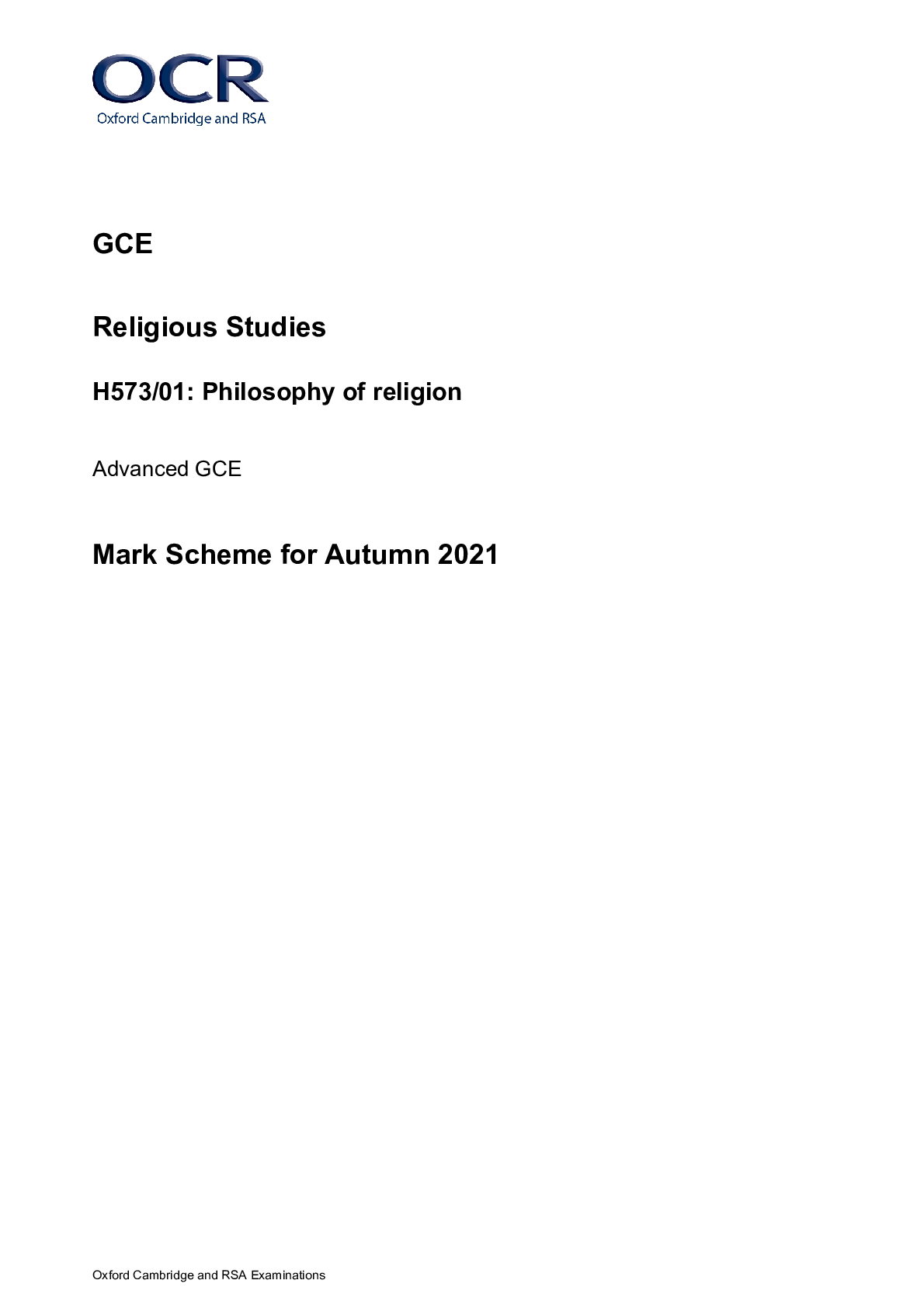
Buy this document to get the full access instantly
Instant Download Access after purchase
Add to cartInstant download
Reviews( 0 )
Document information
Connected school, study & course
About the document
Uploaded On
Oct 07, 2022
Number of pages
17
Written in
Additional information
This document has been written for:
Uploaded
Oct 07, 2022
Downloads
0
Views
30


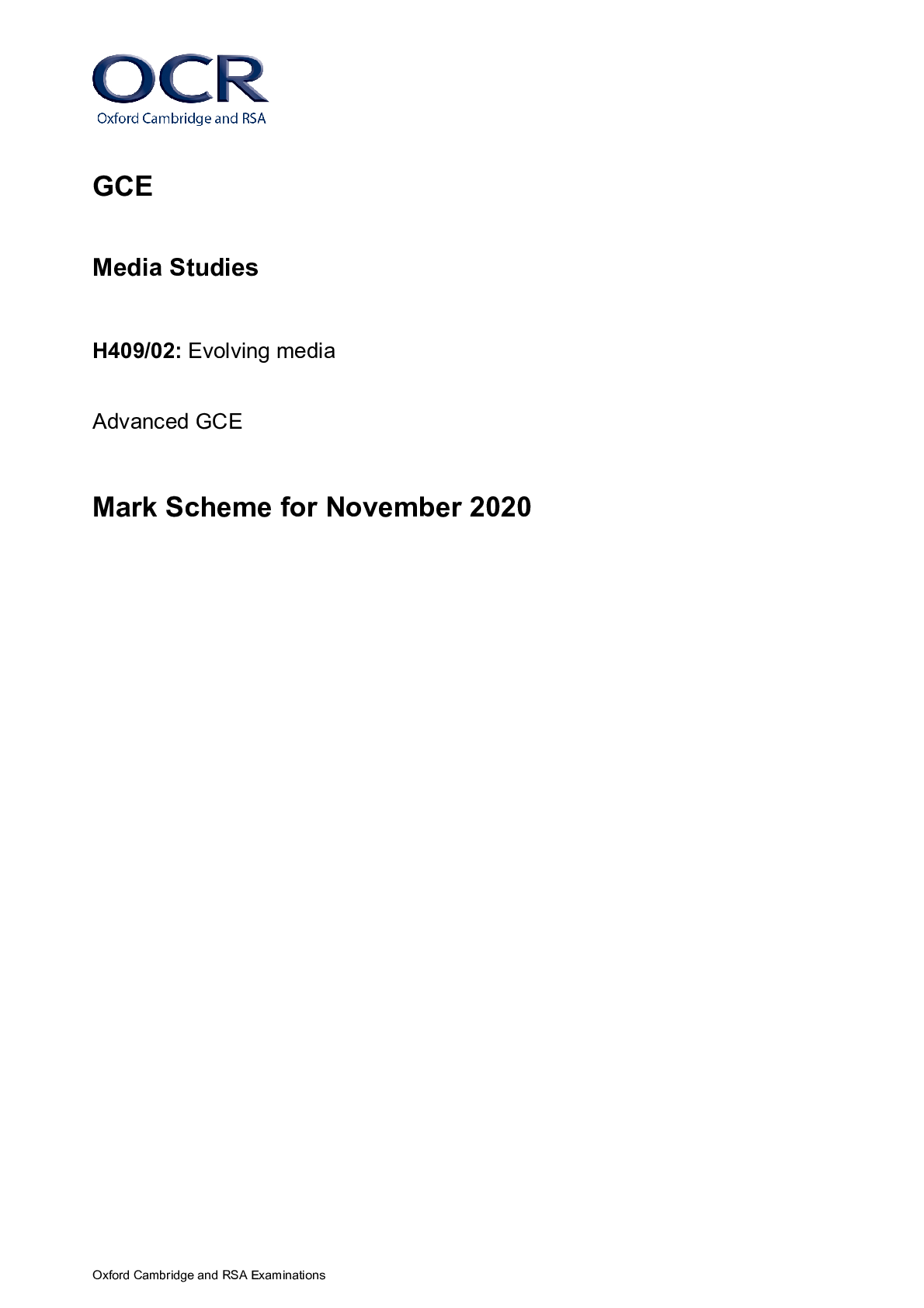
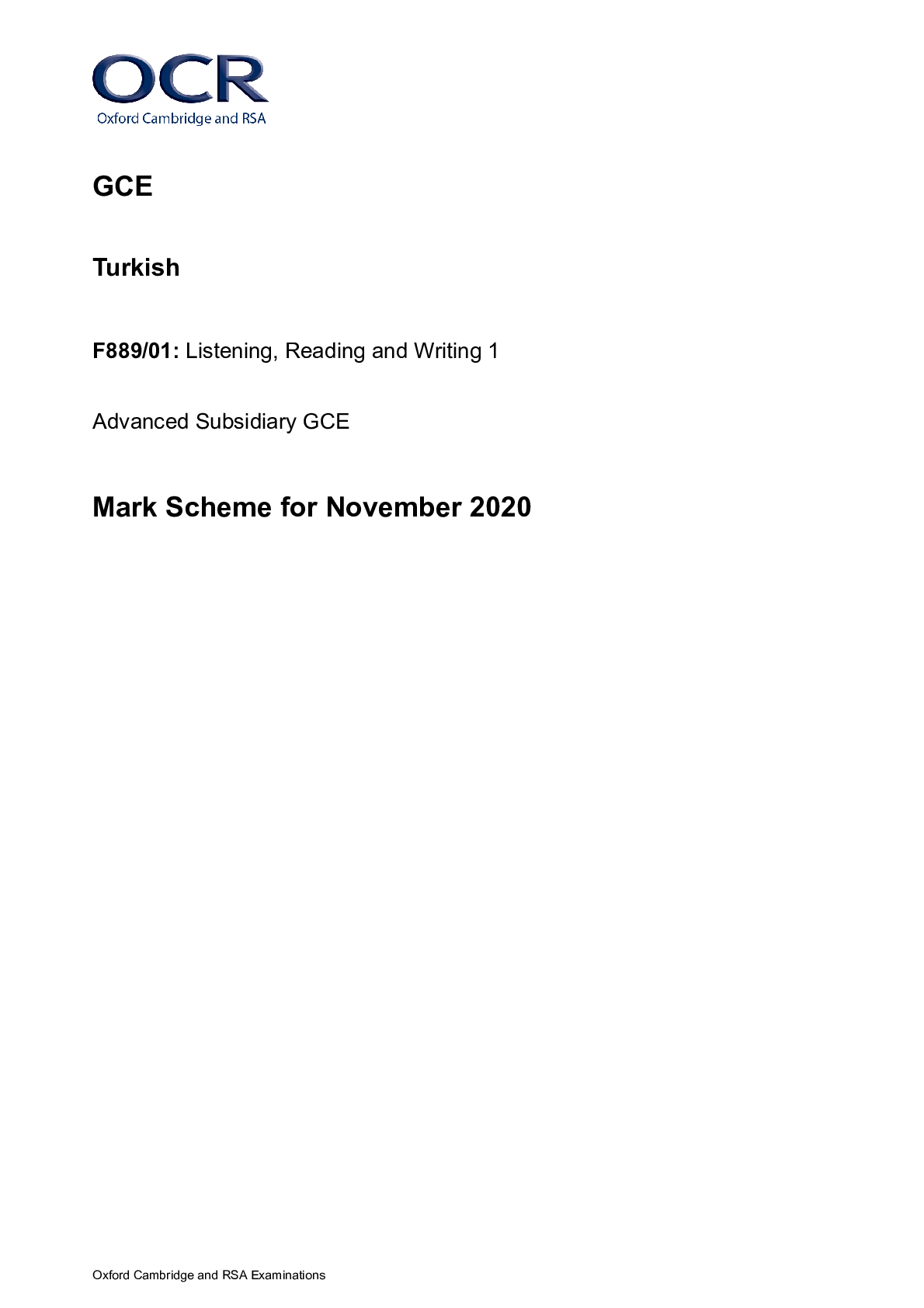
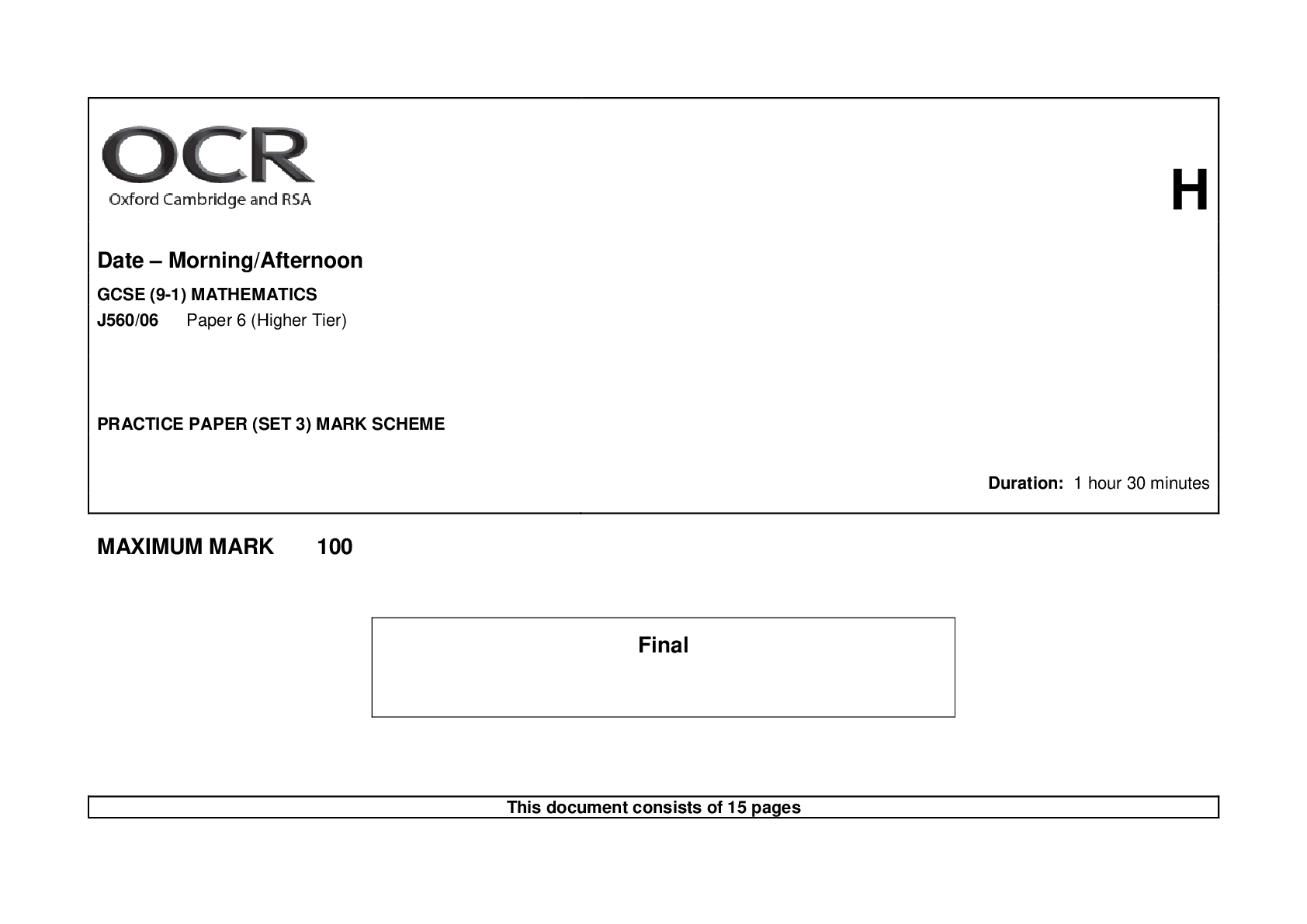


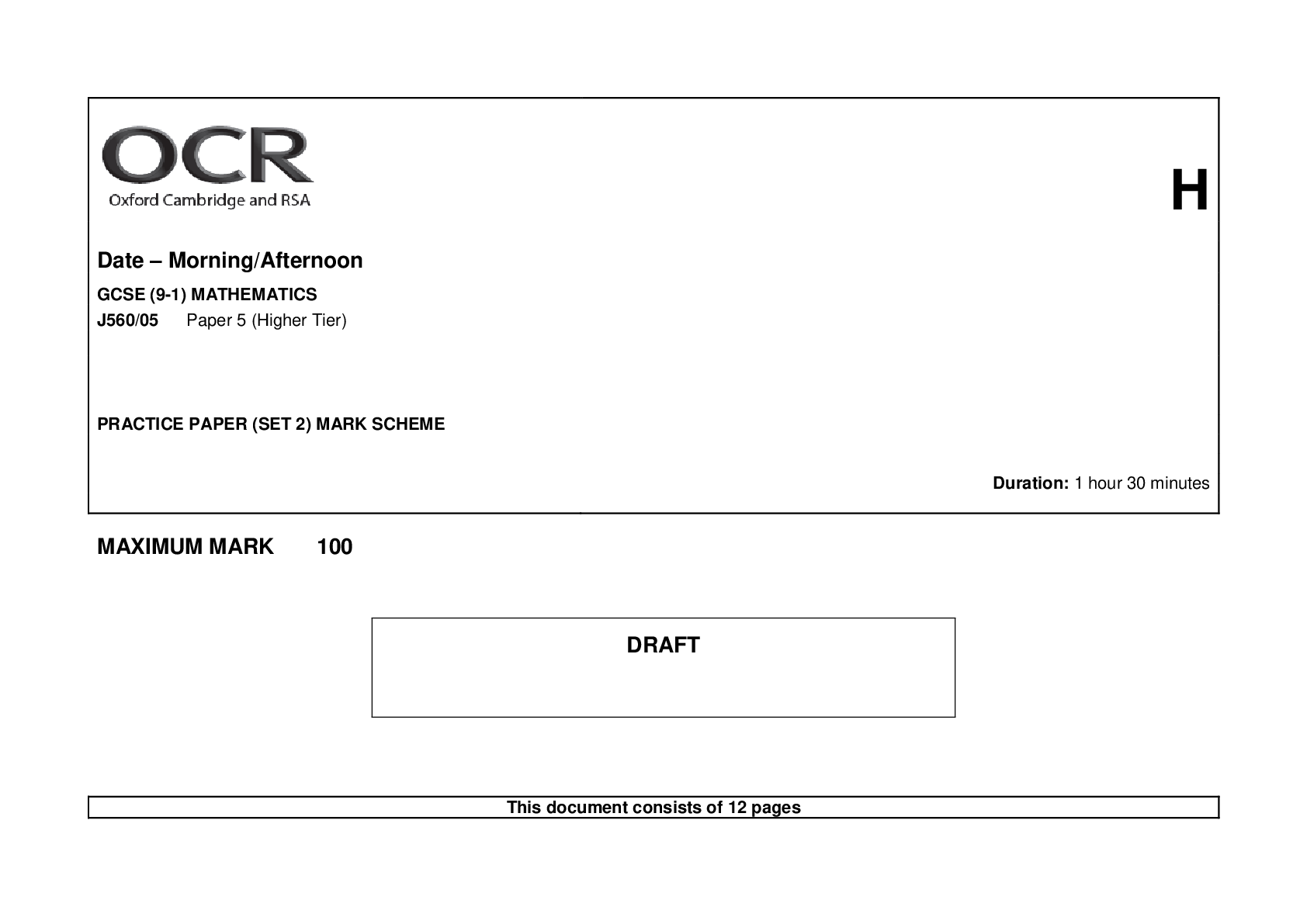
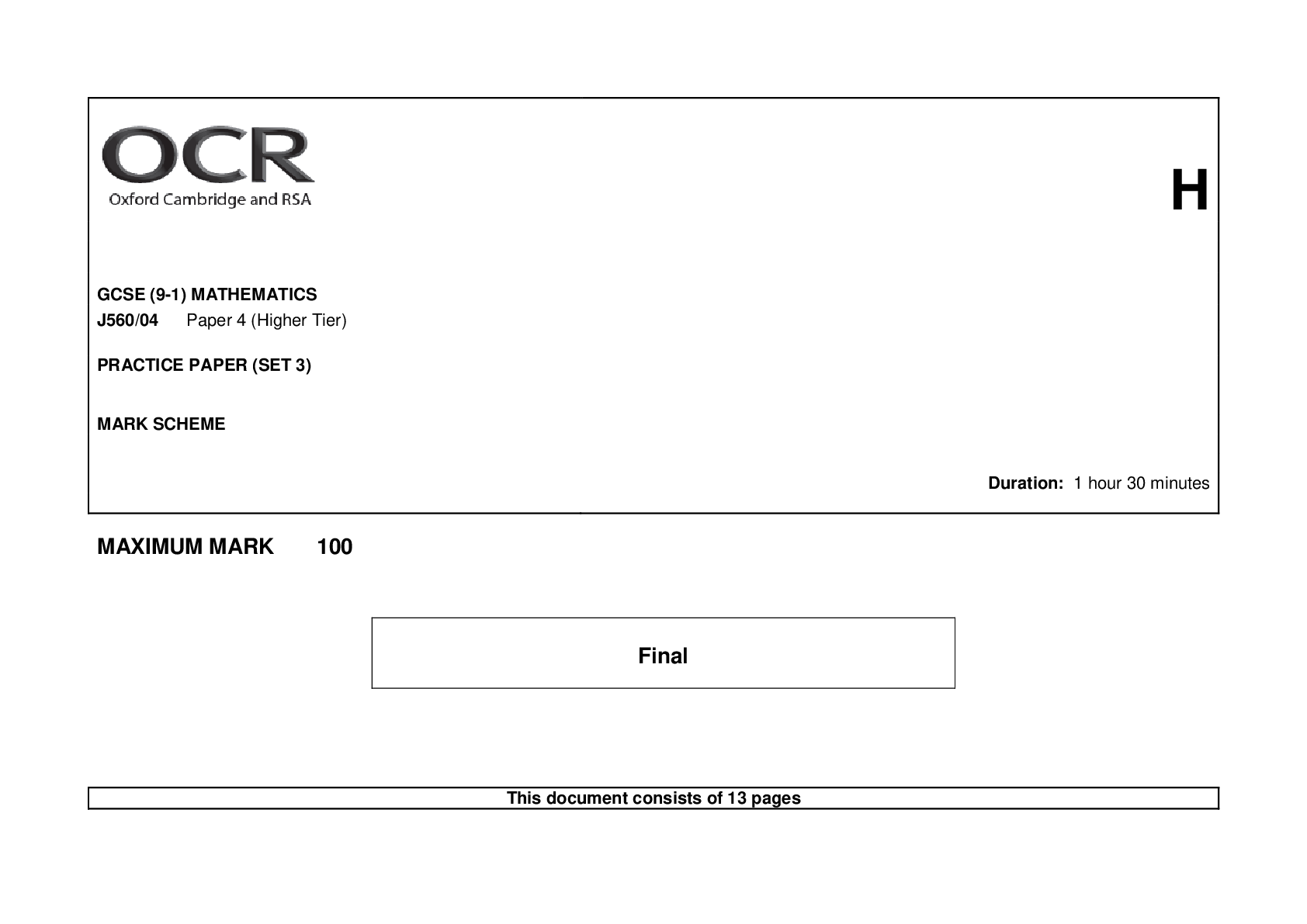



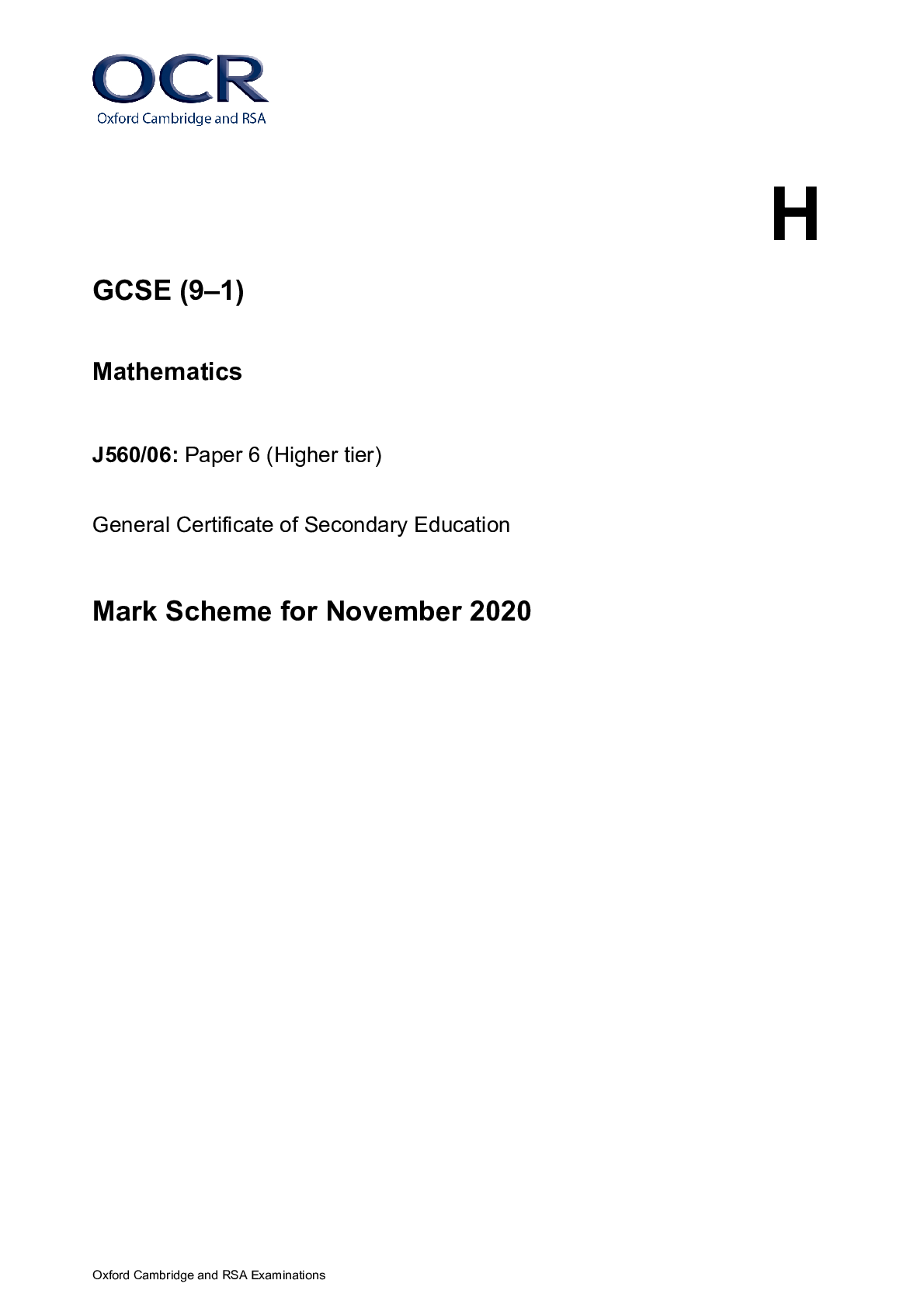
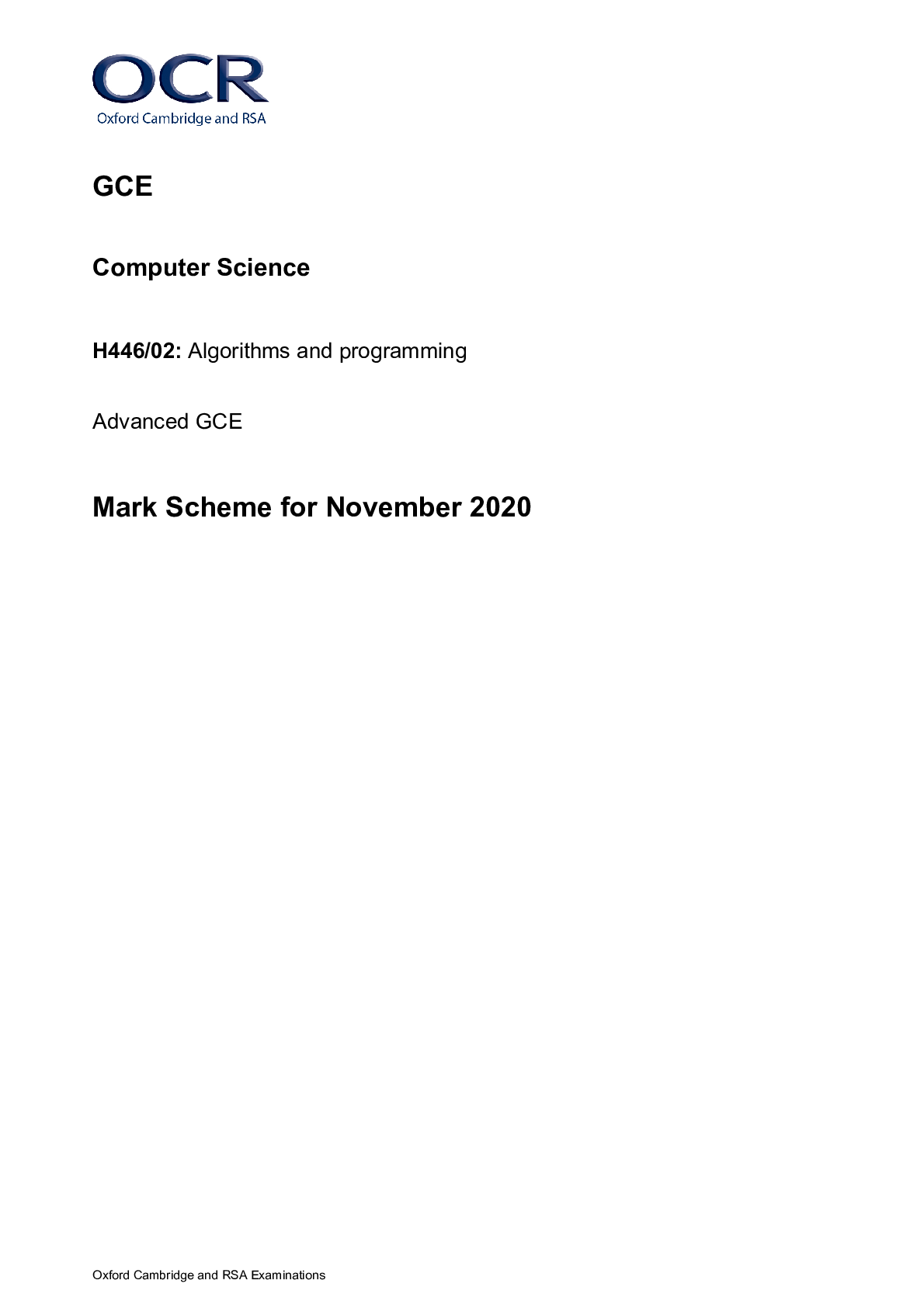
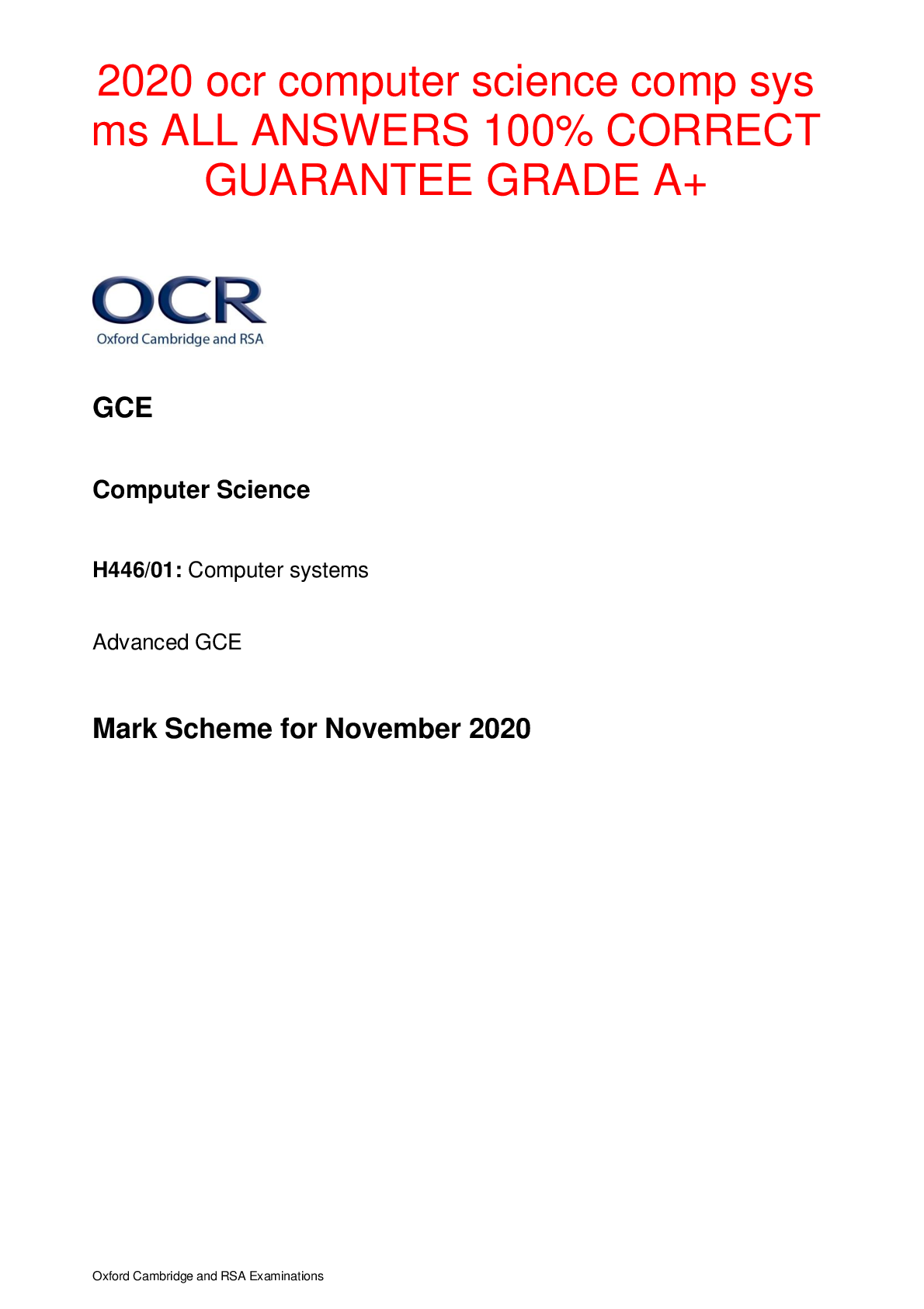

.png)
